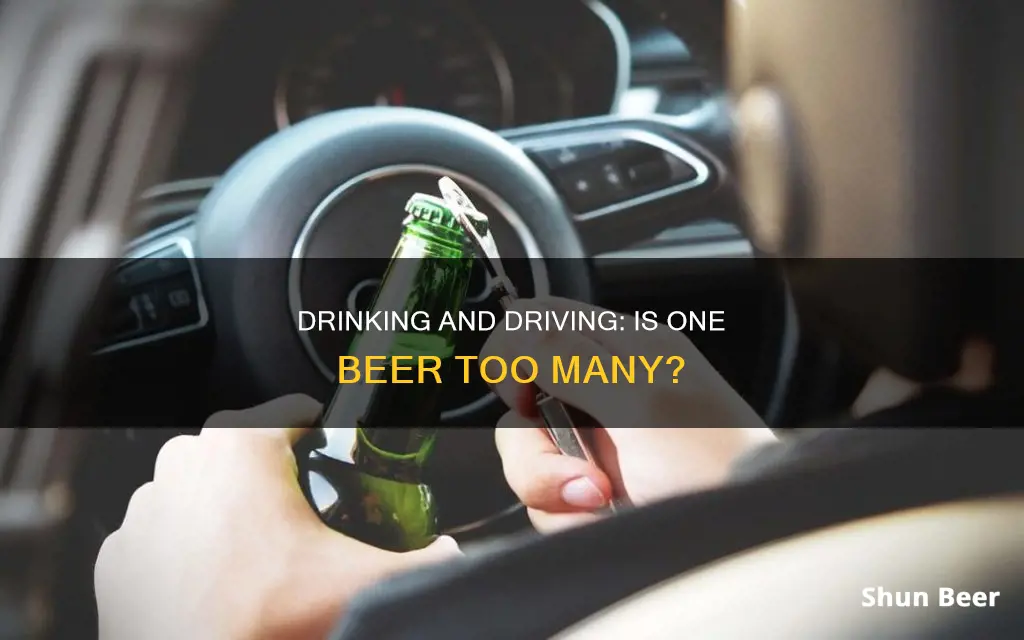
Drinking and driving is a highly debated topic, with varying opinions on the number of drinks one can consume before getting behind the wheel. While some individuals claim that a single beer is negligible and has no impact on their driving ability, others argue that any amount of alcohol can affect one's judgement, reaction time, and coordination. It is important to note that the legal limit for Blood Alcohol Concentration (BAC) is typically set at 0.08%, and one's driving skills can be impaired even if they are under this limit. Factors such as age, biological sex, body weight, food consumption, and drinking speed can influence how alcohol is metabolised and its effects on an individual. Ultimately, the safest option is to refrain from drinking altogether if one plans to drive, as there is no reliable way to determine one's sobriety or guarantee that all alcohol will be eliminated from the system by the next day.
| Characteristics | Values |
|---|---|
| Alcohol metabolism rate | Varies from person to person |
| Factors that affect metabolism rate | Age, biological sex, body weight, food, other substances and medication |
| Blood Alcohol Concentration (BAC) | Determines how drunk a person feels and whether they are legally impaired to drive |
| BAC limit in the United States | .08 grams of alcohol per deciliter (g/dL) or higher |
| BAC limit in many European countries | .05 g/dL |
| BAC limit in Scotland | Lower than in England, Wales and Northern Ireland |
| BAC limit in Georgia for drivers under 21 | From 0.02% to 0.05% |
| Average alcohol removal rate from the body | One unit per hour |
| Ways to eliminate alcohol from the body | Waiting, drinking in moderation, sipping slowly, alternating with non-alcoholic drinks, eating before and while drinking |
What You'll Learn

Blood Alcohol Concentration (BAC)
The amount of alcohol in your blood can vary based on several factors, including the amount of alcohol you consume, how quickly you drink, how much food you ate before drinking, your age, weight, height, gender, metabolism, and the state of your liver. On average, alcohol is removed from the body at a rate of about one unit per hour, but this varies from person to person.
Different BAC levels will result in different physical and mental effects. For example, at a BAC of 0.02%, you may experience an altered mood, relaxation, and a slight loss of judgment. At a BAC of 0.08%, you may have reduced muscle coordination, find it difficult to detect danger, and have impaired judgment and reasoning. As BAC levels increase, the effects become more severe, with BAC levels over 0.40% being potentially fatal.
In the United States, a BAC of 0.08 g/dL or higher is above the legal limit for driving. However, it's important to note that your driving skills can be affected even if you're well under the legal limit. The safest option is to avoid drinking alcohol altogether if you plan to drive.
Beer and Kidney Disease: What's the Connection?
You may want to see also

Factors affecting alcohol metabolism
Several factors influence how quickly alcohol is absorbed and metabolised by the body. Here are some key considerations:
Food Intake
The amount and type of food in the digestive tract have a significant impact on alcohol absorption. Alcohol consumed on an empty stomach is typically absorbed within 15 minutes to 2.5 hours. However, when consumed with a moderate amount of food, this range increases to 30 minutes to 3 hours. On a full stomach, the range can be as long as 3 to 6 hours. Food in the stomach acts like a sponge, delaying alcohol's movement into the small intestine, where most of its absorption occurs.
Speed of Ingestion
The speed at which alcohol is consumed also matters. Consuming large amounts of alcohol quickly may cause the pyloric valve to seize, delaying absorption. On the other hand, drinking over an extended period allows the liver more time to eliminate the alcohol, resulting in a lower blood alcohol level per unit of time.
Type and Strength of Alcohol
The concentration of alcohol in a beverage matters too. High concentrations can adversely affect the pyloric valve, causing delays in stomach emptying. Conversely, some drinks can cause the pyloric valve to spasm, speeding up the process. Mixed drinks are generally absorbed faster than neat spirits.
Gender
Women tend to have higher blood alcohol concentrations than men due to differences in size, weight, and body composition. Women generally have a higher body fat percentage and lower body water volume, which affects alcohol distribution and elimination. Additionally, women have lower levels of the liver enzyme alcohol dehydrogenase, which breaks down alcohol.
Body Weight
Body weight influences how alcohol is distributed in the body. A person with a higher weight has more space for alcohol to diffuse, resulting in a lower concentration of alcohol in the blood, even when consuming the same amount as someone who weighs less.
Age
Age can also impact alcohol metabolism. As the body ages, lean body mass and total volume of distribution tend to decrease, affecting the peak alcohol level achieved after drinking.
Genetics
Genetic factors, especially those related to the different alleles of ADH2 and ALDH2, play a significant role in alcohol metabolism and can influence the development of alcohol dependence.
Medication and Other Substances
Certain medications and recreational substances can affect alcohol metabolism and how an individual experiences the effects of alcohol.
Liver Function
The state of an individual's liver also influences alcohol metabolism. Liver damage or diseases can impair its ability to process alcohol efficiently.
It is important to note that these factors can interact and influence each other, and there may be additional variables that contribute to individual differences in alcohol metabolism. The safest approach is to avoid driving after consuming alcohol, as even small amounts can impair driving ability and affect judgement, coordination, and reaction time.
Is Day-Old Beer Safe to Drink?
You may want to see also

Driving laws in different countries
Drinking and driving is illegal in most countries, but the laws and penalties for driving under the influence of alcohol vary. The acceptable limit of blood alcohol content (BAC) before a person is charged with a crime ranges from zero-tolerance to 0.08%. Some countries have no limits or laws on blood alcohol content.
North America
In the United States, the legal blood alcohol limit is 0.08% or 0.05% BAC by volume, depending on the state. The laws differ between states, with some defining two impaired driving offenses: driving under the influence (DUI) and the illegal per se offense of driving with a BAC of 0.08% or higher. All states have zero-tolerance laws for drivers under 21, with license suspensions for any detectable amount of alcohol in their bloodstream.
Canada also has varying limits depending on the province, ranging from 0.04% to 0.08% BAC by mass. Many provinces have administrative penalties for drunk driving, including license suspensions and fines. Ontario, British Columbia, Newfoundland, and other provinces have zero-tolerance policies for new drivers.
Central and South America
Mexico has a BAC limit of 0.04% to 0.10%.
Brazil practices zero tolerance, with license suspensions, fines, and vehicle seizures for any BAC up to 0.06%. BACs above 0.06% are considered criminal offenses.
Argentina adopted a national zero-tolerance law in 2023, although some provinces retain the old limits.
Chile imposes fines and suspensions for BACs between 0.03% and 0.08%, while BACs over 0.08% carry prison terms, higher fines, and longer suspensions.
Colombia has strict penalties for driving under the influence, with license suspensions, community service, and high fines. In extreme cases, causing injuries or deaths while driving drunk can result in up to 18 years in prison and permanent license cancellation.
Europe
European countries have varying BAC limits, with some differentiating between experienced and novice drivers.
England, Wales, and Northern Ireland have a limit of 0.08% BAC, while Scotland has a lower limit of 0.05% BAC.
Germany has zero tolerance for beginners and professional drivers, with a limit of 0.03% in conjunction with any traffic incident and 0.05% otherwise.
France has a general limit of 0.05% BAC, with lower limits for new drivers and bus drivers.
Greece allows a BAC of up to 0.05%, but this is reduced to 0.02% for unlicensed, new, motorcycle, and professional drivers. BACs above 0.11% are considered misdemeanors with potential imprisonment and license revocation.
Asia
Asian countries also vary in their driving laws related to alcohol consumption.
India has a BAC limit of 0.03%, with imprisonment, fines, or both for drunk driving offenses. Second offenses committed within three years carry harsher punishments.
Malaysia suspects drivers of driving under the influence if they have a BAC above the 0.08% limit, with fines and potential prison sentences of up to six months.
The Philippines requires suspected drunk drivers to undergo sobriety tests, and refusal to comply results in license confiscation.
Turkey imposes license suspensions and fines for drunk driving, with penalties increasing for second and third offenses.
Oceania
In Australia, the BAC limit is 0.05% across all states and territories, with random breath testing conducted by police. Driving with a BAC over 0.08% results in automatic license disqualification, court appearances, and severe penalties.
New Zealand operates a similar program with random breath and drug testing. The BAC limit is 0.05% for people over 20 years old, with fines, demerit points, and license suspensions for exceeding the limit. Higher BACs can result in imprisonment and longer license suspensions.
The Magic of Beer Guns: Filling and Foaming Perfection
You may want to see also

Police advice on drinking and driving
The police and other road safety organisations have clear advice when it comes to drinking and driving: don't do it. The safest option is to avoid alcohol completely if you plan to drive. Even small amounts of alcohol can affect your driving ability and there is no foolproof way to drink and stay within the limit. The only way to eliminate alcohol from your body is to let time pass; there is nothing you can do to speed up the rate at which alcohol leaves your system.
The police can stop vehicles at random and require a breath test if they suspect that a person is driving or attempting to drive under the influence of alcohol. They can also require a breath test if they reasonably believe a person was driving under the influence at the time of an accident. If you are over the limit, you may be detained at a police station. Depending on the type of specimen provided and the results of the breath test, you can either be released without charge, bailed to attend the police station at a later date, or charged and bailed to appear in court.
Alcohol affects your driving ability in several ways. It impairs your judgement, slows your reaction time, makes it hard to focus, affects your ability to control the car or speed, reduces coordination, and inhibits your ability to track moving objects. Even if you feel fine, your driving skills can be affected, and you may be legally considered too impaired to drive. In the US, a Blood Alcohol Concentration (BAC) of .08 grams of alcohol per deciliter (g/dL) or higher is above the legal limit, while in many European countries, the limit is lower at .05 g/dL.
If you are planning to drive, it is best to decide on a drink limit ahead of time and stick to it. Sip your drinks slowly and alternate with non-alcoholic beverages. Opt for drinks with a lower alcohol content and be sure to eat something before and while you are drinking. If you are unsure whether it is safe for you to drive, it is always best to err on the side of caution and not get behind the wheel. Make other arrangements for a ride home or take the time to sleep it off before driving.
BeerSmith Compatibility: Apple Devices and Beyond
You may want to see also

Effects of alcohol on driving ability
Alcohol affects your driving ability in several ways. Firstly, it impairs your judgement and slows your reaction time, making it difficult to focus on the task of driving. Alcohol also affects your ability to control the speed and direction of the car, reduces your coordination, and inhibits your ability to track moving objects. These effects can be dangerous and lead to accidents, injuries, or even fatalities.
The amount of alcohol in your bloodstream depends on several factors, including the amount you consume, the period over which you consume it, and how quickly your body can process and eliminate it. On average, the body can remove alcohol at a rate of about one unit per hour, but this varies from person to person. Factors such as size, gender, food intake, liver function, and metabolism all play a role in how your body handles alcohol.
It's important to note that even small amounts of alcohol can affect your driving ability, and there is no fool-proof way to drink and stay within the legal limit. The safest option is to avoid alcohol completely if you plan to drive. Drinking and driving is a dangerous combination, and it's not worth risking your safety and the safety of others.
In terms of legal consequences, driving under the influence of alcohol can result in charges such as driving without due care and attention, or even DUI (Driving Under the Influence). The legal limit for Blood Alcohol Concentration (BAC) is typically set at 0.08%, but this can vary by country and region. For young drivers under the age of 21, some places have zero-tolerance laws, where any positive result on a breath test can lead to arrest and charges.
Overall, the effects of alcohol on driving ability are significant and can impair your ability to operate a vehicle safely. It is essential to make alternative arrangements for transportation if you plan to consume alcohol, as driving after drinking can put yourself and others at risk.
Beer and Surgery: What's the Safe Wait Time?
You may want to see also
Frequently asked questions
It depends on several factors, including your body weight, whether you have eaten, your metabolism, and the time elapsed since you finished your drink. It is best to wait for at at least an hour after drinking a beer before driving.
Alcohol impairs your judgment, slows your reaction time, and reduces coordination and control over the vehicle. Even if you are under the legal limit, your driving skills can be affected, and you may face legal consequences.
The Blood Alcohol Concentration (BAC) limit is typically 0.08%. However, this varies by country and state, with some places having a lower limit or a zero-tolerance policy for underage drivers.
On average, alcohol is removed from the body at a rate of about one unit per hour. However, this can vary depending on individual factors such as size, gender, food intake, liver function, and metabolism.
No, there is no reliable way to quickly sober up. The only way to eliminate alcohol from your system is to let time pass. Drinking coffee or taking a cold shower might make you feel slightly different, but they will not eliminate alcohol from your body.







